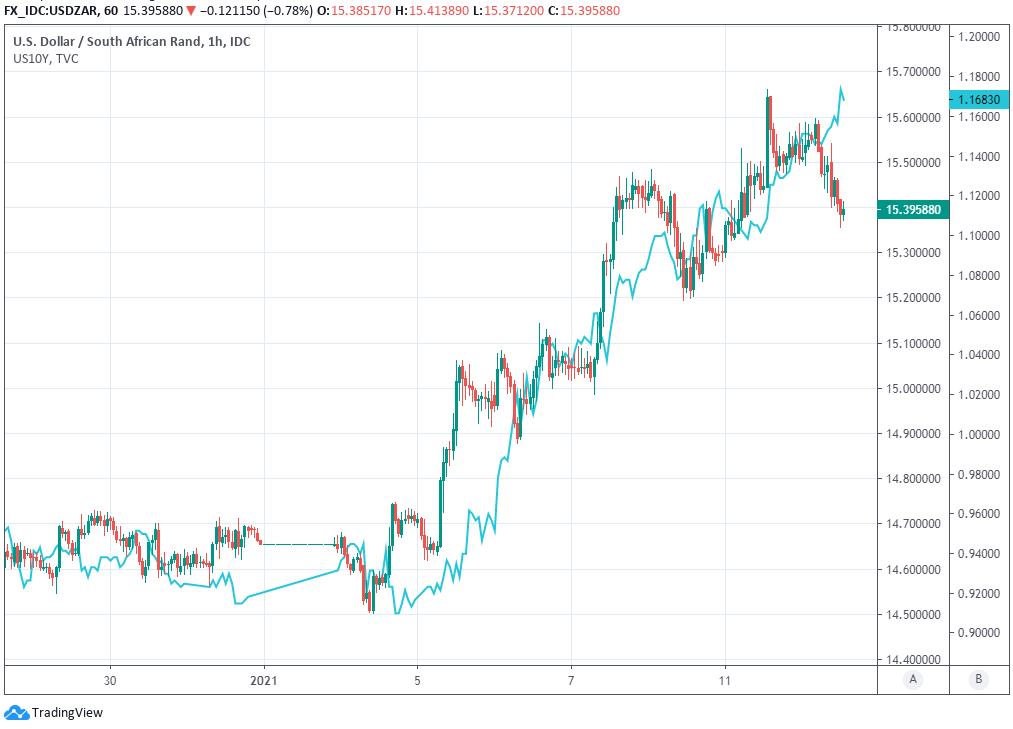South African Rand Could Have Further to Fall if U.S. Bond Sell-off Continues
- Written by: James Skinner
-

Above: South Africa's economy is expected by the SARB to shrink 7.0% in 2020. File image © GovernmentZA.
- GBP/ZAR spot rate at time of writing: 20.93
- Bank transfer rate (indicative guide): 20.20-20.35
- FX specialist providers (indicative guide): 20.62-20.79
- More information on FX specialist rates here
The Rand topped the board among major developed and emerging market currencies on Tuesday as bond markets stabilised in North America and Europe, although if U.S. yields continue to rise in the weeks and months ahead, the South African currency could have further to fall.
South Africa’s Rand was higher against its nine largest emerging market rivals and all major currencies on Tuesday as calm appeared to return to the American government bond market. U.S. yields still rose again but their increases were much less than in prior sessions.
Nonetheless, some analysts have urged caution for the time being because a further, potentially destabilising surge in yields cannot yet be ruled out.
"We are not yet convinced the correction lower is complete," says Lee Hardman, a currency analyst at MUFG. "The 10-year UST yield has increased by around 20 basis points since the start of last week. The largest increase in nominal US yields since the initial aftermath of the US election, although on that occasion they did not trigger a stronger USD."
Above: USD/ZAR shown at hourly intervals alongside 10-year U.S. bond yield (blue line).
Last week’s Democratic Party victory in the Georgia State election and U.S. rate setters’ ongoing suggestions that the Federal Reserve could taper off its quantitative easing programme sooner than markets gave credit for have lifted American bond yields sharply thus far in the New Year. Higher spending in Washington is now almost a foregone conclusion while doubts about the Fed’s appetite for U.S. bonds could linger for some time yet, posing a risk to the Rand.
"Our trading desk acknowledges that the sell-off in US [bonds] as a risk and therefore continues to hold long USDJPY as a hedge to our overall USD shorts," Rui Ding, an associate at Citi FX. "Downside to ZAR is also amplified from large outflows in ZAR denominated bonds seen in the market. There was little to report on the local front over the weekend, but our traders flag activity on USDZAR selling was seen around the 15.40 handle and we expect appetite to fade USD strength will pick up should USDZAR continue to trend higher."
{wbamp-hide start}{wbamp-hide end}{wbamp-show start}{wbamp-show end}
Rising U.S. yields can reduce the investment appeal of government debt in South Africa and other emerging markets, leading to outflows from local bond funds and downward pressure on the currency, as has been seen already. This partly explains why the main Rand exchange rate USD/ZAR has risen steadily alongside the increase in U.S. yields, from 14.50 to the midpoint of a 14.50-to-16.50 2021 range anticipated by analysts at Rand Merchant Bank.
“Foreigners reversed tack in Q4.20, purchasing R6.1bn worth of SA debt on a net basis, but then sold the entire amount in the first week of January, as risk aversion levels started to build,” says Annabel Bishop, chief economist at Investec. “The domestic currency will remain vulnerable to volatility both this year and further out, given the high risk status of its portfolio assets, with SA showing no progress towards reducing its debt quantum, while prospects for substantially faster GDP growth are seen as muted.”
Above: USD/ZAR at daily intervals with Pound-to-Rand rate (blue line).
"USD/ZAR has staged an impressive rebound regaining all the lost ground in December after forming a low near 14.55/14.50, the lower limit of a descending channel and the 61.8% retracement from 2018," says Carole Laulhere, an FX and rates strategist at Societe Generale. "The pair has entered the territory of the Ichimoku cloud in daily time frame. It is likely to head higher gradually towards 15.75 with the next hurdle at the channel upper band near 16.10/16.35. This must be reclaimed for an extended bounce."
The Rand also faces homegrown risks in surging coronavirus infections that prompted President Cyril Ramaphosa to announce the closure of the country’s land borders on Monday and extend an adjusted Alert Level 3 so that restrictions on activity resulting from it continue into February.
"Government has taken a more practical response to the second wave than the first so far," says Investec's Bishop. "Focussing on limiting social interactions as much as possible, as opposed to a hard lockdown on the economy, and so on the majority of its citizens livelihoods, is a much less damaging path to take, and will reduce the harm the second wave causes on livelihoods."
{wbamp-hide start} {wbamp-hide end}{wbamp-show start}{wbamp-show end}
Virus challenges are pertinent because emerging market currencies were widely expected in the analyst community to be the foremost beneficiaries of an extended U.S. Dollar decline this year. But South African and broader emerging market inflows now face being held up by renewed waves of infection.
“USD/ZAR has been trading in a tight range above its 14.5044 December trough over the past few weeks before suddenly surging higher at the beginning of this year and reaching the 15.4966/15.7362 resistance area. It is made up of the mid-to-late November highs which may short-term cap. Once overcome, however, the 2020-2021 resistance line at 15.8667 and also the 16.0838/16.4977 resistance area will be in the pipeline,” says Axel Rudolph, a senior technical analyst at Commerzbank. “Further up meanders the 200 day moving average at 16.7380.”
South Africa is now grappling with a new and more infectious variant of the coronavirus while all emerging markets generally are facing prolonged wait times before they can secure sufficient doses of the various new vaccines for population immunity to be achieved.
Above: USD/ZAR at weekly intervals with Fibonacci retracements of 2018 uptrend and 55-week (orange), 200-week (purple) averages. GBP/ZAR shown in blue.

